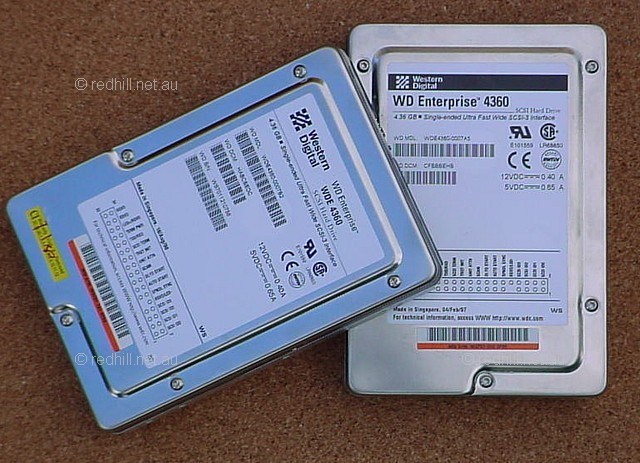
Photo: Red Hill.
Western Digital Enterprise drives
For all of Western Digital's long-established prominence on the consumer desktop, WD was never more than a bit player in the SCSI market where the real money was to be made. Eventually, no doubt rather tired of the poor profits to be found in the ultra-competitive high-volume consumer world of IDE, Western Digital sest up a new division to design and manufacture SCSI drives. This was in late 1994; the first products started shipping in mid-1996.
Sensibly, WD concentrated on the mainstream lines where it could leverage existing manufacturing skills, leaving the specialised ultra high-speed and ultra-high capacity models to the two giants of the SCSI market, IBM and Seagate.
Illustration: a pair of WDE4360s. Notice the different appearance: from the fancier label you would assume that the drive on the right is the newer of the two — cosmetic changes are usually made to improve the look of a drive, after all — but in fact the right-hand drive was made in 1997, the left-hand one in 1998.
The plan was to have a series of Enterprise drives in both 7200 and 10,000 RPM classes and sizes up to 18GB. The earlier products in particular were well-placed to compete with the established players, being as fast or faster than all but the very latest and most expensive 7200 RPM drives from Seagate and IBM, and were priced very reasonably by SCSI standards. But despite doing nearly everything right, Western Digital never did become a significant player in the enterprise storage world. SCSI drives wound up accounting for more than ten percent of WD's sales revenue, which was not enough to make the enterprise unit self-funding, particularly as WD was not the only company trying to break into that market. It was probably a little late to be getting into SCSI; margins were falling by this time and development costs getting ever higher. All in all, the late '90s was a very difficult time for drive makers. After several years of losses in the mainstream IDE business, Western Digital simply ran out of money. WD sold its disc manufacturing facilities to Komag, dropped its innovative notebook line, and at the beginning of 2000, announced the closure of the SCSI operation.
| WD Enterprise | Performance | 1.23 | |
| Data rate | 140 Mbit/sec | Spin rate | 7200 RPM |
| Seek time | 7.9ms | Buffer | 512k |
| Platter capacity | 1.1GB | Interface | Fast wide SCSI |
| Read channel | PRML | Head technology | MR |
| WDE2170 | 2.17GB | 4 heads | 1/3 height |
| WDE4360 | 4.36GB | 8 heads | 1/3 height |